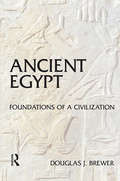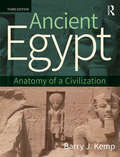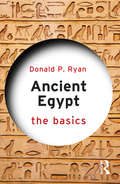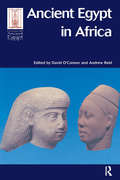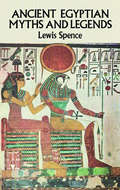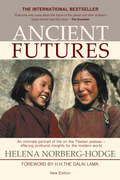- Table View
- List View
Ancient Egypt: Foundations of a Civilization
by Douglas J. BrewerAncient Egypt is a beautifully illustrated, easy-to-read book covering the formative era of the Egyptian civilization: the age before the pyramids. Douglas Brewer shows why an awareness of the earliest phase of Egyptian history is crucial to understanding of later Egyptian culture. Beginning with a quick review of the fields of Egyptology and archaeology, Ancient Egypt takes the reader on a compelling survey of Egypt's prehistoric past. The books tours the Nile Valley to explore its impact on all aspects of life, from day-to-day living to regional politics, and introduces the reader to the Nile Valley's earliest inhabitants and the very first "Egyptians".
Ancient Egypt: An Introduction (PDF)
by Salima IkramThis book provides an introduction to one of the greatest civilizations of all time - ancient Egypt. Beginning with a geographical overview that explains the development of Egyptian belief systems as well as its subsequent political development, it examines methodology, the history of the discipline of Egyptology, religion, social organization, urban and rural life, and death. It also includes a section on how people of all ranks lived. Lavishly illustrated, with many unusual photographs of rarely seen sites that are seldom illustrated, this volume is suitable for use in introductory-level courses on ancient Egypt. It offers a variety of student-friendly features, including a glossary, a bibliography, and a list of sources for those who wish to further their interest in ancient Egypt.
Ancient Egypt: Anatomy of a Civilization
by Barry J. KempThis fully revised and updated third edition of the bestselling Ancient Egypt seeks to identify what gave ancient Egypt its distinctive and enduring characteristics, ranging across material culture, the mindset of its people, and social and economic factors. In this volume, Barry J. Kemp identifies the ideas by which the Egyptians organized their experience of the world and explains how they maintained a uniform style in their art and architecture across three thousand years, whilst accommodating substantial changes in outlook. The underlying aim is to relate ancient Egypt to the broader mainstream of our understanding of how all human societies function. Source material is taken from ancient written documents, while the book also highlights the contribution that archaeology makes to our understanding of Egyptian culture and society. It uses numerous case studies, illustrating them with artwork expressly prepared from specialist sources. Broad ranging yet impressively detailed, the book is an indispensable text for all students of ancient Egypt and for the general reader.
Ancient Egypt: Anatomy of a Civilization (All That Matters Ser.)
by Barry J. KempThis fully revised and updated third edition of the bestselling Ancient Egypt seeks to identify what gave ancient Egypt its distinctive and enduring characteristics, ranging across material culture, the mindset of its people, and social and economic factors. In this volume, Barry J. Kemp identifies the ideas by which the Egyptians organized their experience of the world and explains how they maintained a uniform style in their art and architecture across three thousand years, whilst accommodating substantial changes in outlook. The underlying aim is to relate ancient Egypt to the broader mainstream of our understanding of how all human societies function. Source material is taken from ancient written documents, while the book also highlights the contribution that archaeology makes to our understanding of Egyptian culture and society. It uses numerous case studies, illustrating them with artwork expressly prepared from specialist sources. Broad ranging yet impressively detailed, the book is an indispensable text for all students of ancient Egypt and for the general reader.
Ancient Egypt: The Basics (The Basics)
by Donald P. RyanAncient Egypt: The Basics offers an accessible and comprehensive introduction to the history, archaeology and influence of this fascinating civilization. Coverage includes: A survey of Egyptian history from its earliest origins to the coming of Islam Life and death in ancient Egypt Key archaeological discoveries and important characters Egypt’s impact and reception through to the modern day Lively and engaging, this is an indispensable resource for anyone beginning their studies of Egyptian history, culture and archaeology, and a must-read for anyone who wants to learn more about the country’s long and captivating past.
Ancient Egypt: The Basics (The Basics #2)
by Donald P. RyanAncient Egypt: The Basics offers an accessible and comprehensive introduction to the history, archaeology and influence of this fascinating civilization. Coverage includes: A survey of Egyptian history from its earliest origins to the coming of Islam Life and death in ancient Egypt Key archaeological discoveries and important characters Egypt’s impact and reception through to the modern day Lively and engaging, this is an indispensable resource for anyone beginning their studies of Egyptian history, culture and archaeology, and a must-read for anyone who wants to learn more about the country’s long and captivating past.
Ancient Egypt in Africa (Encounters with Ancient Egypt)
by David O'Connor Andrew ReidGeographically, Egypt is clearly on the African continent, yet Ancient Egypt is routinely regarded as a non-African cultural form. The significance of Ancient Egypt for the rest of Africa is a hotly debated issue with complex ramifications. This book considers how Ancient Egypt was dislocated from Africa, drawing on a wide range of sources. It examines key issues such as the evidence for actual contacts between Egypt and other early African cultures, and how influential, or not, Egypt was on them. Some scholars argue that to its north Egypt's influence on Mediterranean civilization was downplayed by western scholarship. Further a field, on the African continent perceptions of Ancient Egypt were colored by biblical sources, emphasizing the persecution of the Israelites. An extensive selection of fresh insights are provided, several focusing on cultural interactions between Egypt and Nubia from 1000 BCE to 500 CE, developing a nuanced picture of these interactions and describing the limitations of an 'Egyptological' approach to them.
Ancient Egypt in Africa (Encounters with Ancient Egypt)
by Andrew Reid David O’ConnorGeographically, Egypt is clearly on the African continent, yet Ancient Egypt is routinely regarded as a non-African cultural form. The significance of Ancient Egypt for the rest of Africa is a hotly debated issue with complex ramifications. This book considers how Ancient Egypt was dislocated from Africa, drawing on a wide range of sources. It examines key issues such as the evidence for actual contacts between Egypt and other early African cultures, and how influential, or not, Egypt was on them. Some scholars argue that to its north Egypt's influence on Mediterranean civilization was downplayed by western scholarship. Further a field, on the African continent perceptions of Ancient Egypt were colored by biblical sources, emphasizing the persecution of the Israelites. An extensive selection of fresh insights are provided, several focusing on cultural interactions between Egypt and Nubia from 1000 BCE to 500 CE, developing a nuanced picture of these interactions and describing the limitations of an 'Egyptological' approach to them.
Ancient Egyptian Beads
by Nai XiaThis book presents a detailed analysis and thorough study of the unique collection of Ancient Egyptian beads in the Petrie Museum of Egyptian Archaeology in London.The book first discusses the archaeological value of beads and the method employed in the study of them, especially emphasizing the importance of the technique of bead-making for dating purposes. It then examines and evaluates various schemes for the classification of beads. The book goes on to propose a new classification system and works out a comprehensive corpus of beads with the aid of sixteen plates.Next, the book features a chronological survey that details the material, typology (including the technical peculiarities), use, arrangement and pictorial representation of beads throughout the nine divisions or periods of Ancient Egyptian history. This survey points out the characteristics of each period as well any contact Egypt may have experienced with foreign countries as shown by the beads. It also corrects much wrong identifications of materials and mistaken datings.This book is based on the Ph.D dissertation written by pioneering Chinese archaeologist Xia Nai when he studied in London College University some 70 years ago and who had direct access to considerable firsthand resources at the forefront of Egyptology research. It represents a crucial and long-awaited advance in archaeology, not only for Egypt but for the study of the past across Africa and beyond.
Ancient Egyptian Myths and Legends
by Lewis Spence"Let us walk in the gloom of the pyramids, in the cool shadows of ruined temples, aye, through the tortuous labyrinth of the Egyptian mind itself, trusting that by virtue of the light we carry we shall succeed in unravelling to some extent the age-long enigma of this mystic land." — from Chapter One.In this classic study, a noted mythologist made perhaps the first serious attempt to review the religious history of ancient Egypt in the light of the science of modern mythology. Instead of regarding Egyptian mythology and legend as unique, "classic" and inviolate, as did many Egyptologists, Spence saw Egyptian religious thought as part of world mythology, rooted in primitive conceptions common to mankind as a whole and related to those of many other cultures. In supporting this thesis, Spence offers an immensely erudite in-depth survey of the broad spectrum of Egyptian gods and goddesses, cults, and beliefs, as well as a concise review of Egyptian history, manners, customs, and archaeology.Animism, totemism, fetishism, creation myths, and other aspects of early religious beliefs are explored in an introductory chapter. The author then goes on to discuss the Egyptian priesthood, mysteries and temples, the cult of Osiris; Ra the Sun-God, Anubis, Horus, Thoth, and numerous other deities; the Book of the Dead, the birth of Hatshepsut, sacred trees, alchemy, the festival of Bast, Egyptian art, magic, and amulets, legends; and a host of other topics.Enhanced with over 50 photographs and illustrations, this book belongs in the library of any student of ancient Egypt or of early man's attempts, through mythology and legend, to give order, meaning, and purpose to his world.
Ancient Egyptian Scribes: A Cultural Exploration (Bloomsbury Egyptology)
by Niv Allon Hana NavratilovaThe modern view of the ancient Egyptian world is often through the lens of a scribe: the trained, schooled, literate individual who was present at many levels of Egyptian society, from a local accountant to the highest echelons of society. And yet, despite the wealth of information the scribes left us, we know relatively little about what underpinned their world, about their mentality and about their everyday life. Tracing ten key biographies, Ancient Egyptian Scribes examines how these figures kept both the administrative life and cultural memory of Egypt running. These are the Egyptians who ran the state and formed the supposedly meritocratic system of local administration and government. Case studies look at accountants, draughtsmen, scribes with military and dynastic roles, the authors of graffiti and literati who interacted in different ways with Pharaohs and other leaders. Assuming no previous knowledge of ancient Egypt, the various roles and identities of the scribes are presented in a concise and accessible way, offering structured information on their cultural identity and self-presentation, and providing readers with an insight into the making of Egyptian written culture.
Ancient Egyptian Scribes: A Cultural Exploration (Bloomsbury Egyptology)
by Niv Allon Hana NavratilovaThe modern view of the ancient Egyptian world is often through the lens of a scribe: the trained, schooled, literate individual who was present at many levels of Egyptian society, from a local accountant to the highest echelons of society. And yet, despite the wealth of information the scribes left us, we know relatively little about what underpinned their world, about their mentality and about their everyday life. Tracing ten key biographies, Ancient Egyptian Scribes examines how these figures kept both the administrative life and cultural memory of Egypt running. These are the Egyptians who ran the state and formed the supposedly meritocratic system of local administration and government. Case studies look at accountants, draughtsmen, scribes with military and dynastic roles, the authors of graffiti and literati who interacted in different ways with Pharaohs and other leaders. Assuming no previous knowledge of ancient Egypt, the various roles and identities of the scribes are presented in a concise and accessible way, offering structured information on their cultural identity and self-presentation, and providing readers with an insight into the making of Egyptian written culture.
Ancient Engineers' Inventions: Precursors of the Present (History of Mechanism and Machine Science #33)
by Cesare Rossi Flavio RussoThis book describes the inventions and designs of ancient engineers who are the precursors of the present. The period ranges mainly from 300 B.C. to 1600 A.D. with several exceptions. Many of the oldest inventions are documented by archaeological finds, often very little known, mainly from Pompeii, Herculaneum and Stabiae and reveal a surprising modernity in their conception.Most of the inventions presented in the first four parts of this book were conceived up to the late Roman Empire and may be considered as milestones, each in their respective field. The fifth part concentrates on more recent centuries. The sixth part deals with some building construction techniques.Generally, for each of the presented inventions, three elements of research and reference are provided: written documents (the classics), iconic references (coins, bas-reliefs, etc.) and archaeological findings.The authors did not write this book for engineers only; hence they describe all the devices without assuming wide technical knowledge. The authors’ main aim is to try to communicate their enthusiasm for the inventions and the inventors of the past and to contribute to the fascinating study of the History of Engineering.This second edition includes new topics and chapters that are of special interest to engineers.
Ancient Engineers' Inventions: Precursors of the Present (History of Mechanism and Machine Science #8)
by Cesare Rossi Flavio Russo Ferruccio RussoWe live in an age in which one can easily think that our generation has invented and discovered almost everything; but the truth is quite the opposite. Progress cannot be considered as sudden unexpected spurts of individual brains: such a genius, the inventor of everything, has never existed in the history of humanity. What did exist was a limitless procession of experiments made by men who did not waver when faced with defeat, but were inspired by the rare successes that have led to our modern comfortable reality. And that continue to do so with the same enthusiasm. The study of the History of Engineering is valuable for many reasons, not the least of which is the fact that it can help us to understand the genius of the scientists, engineers and craftsmen who existed centuries and millenniums before us; who solved problems using the devices of their era, making machinery and equipment whose concept is of such a surprising modernity that we must rethink our image of the past.
Ancient Ethnography: New Approaches
by Eran Almagor Joseph SkinnerEthnographic writing has become all but ubiquitous in recent years. Although now considered a thoroughly modern and increasingly indispensable field of study, Ethnography's roots go all the way back to antiquity. This volume brings together eleven original essays exploring the wider intellectual and cultural milieux from which ancient ethnography arose, its transformation and development in antiquity, and the way in which 19th century receptions of ethnographic traditions helped shape the modern study of the ancient world. Finally, it addresses the extent to which all these themes remain inextricably intertwined with shifting and often highly contested notions of culture, power and identity. Its chapters deal with the origins of the term 'barbarian', the role of ethnography in Tacitus' Germania, Plutarch's Lives, Xenophon's Anabasis, and Athenaeus' Deipnosophistae, Herodotean storytelling, Henry and George Rawlinson, and Megasthenes' treatise on India. At a time when modern ethnographies are becoming increasingly prevalent, wide-ranging, and experimental in their approach to describing cultural difference, this book encourages us to think about ancient ethnography in new and interesting ways, highlighting the wealth of material available for study and the complexities underpinning ancient and modern notions of what it meant to be Greek, Roman or 'barbarian'.
Ancient Ethnography: New Approaches
by Eran Almagor Joseph SkinnerEthnographic writing has become all but ubiquitous in recent years. Although now considered a thoroughly modern and increasingly indispensable field of study, Ethnography's roots go all the way back to antiquity. This volume brings together eleven original essays exploring the wider intellectual and cultural milieux from which ancient ethnography arose, its transformation and development in antiquity, and the way in which 19th century receptions of ethnographic traditions helped shape the modern study of the ancient world. Finally, it addresses the extent to which all these themes remain inextricably intertwined with shifting and often highly contested notions of culture, power and identity. Its chapters deal with the origins of the term 'barbarian', the role of ethnography in Tacitus' Germania, Plutarch's Lives, Xenophon's Anabasis, and Athenaeus' Deipnosophistae, Herodotean storytelling, Henry and George Rawlinson, and Megasthenes' treatise on India. At a time when modern ethnographies are becoming increasingly prevalent, wide-ranging, and experimental in their approach to describing cultural difference, this book encourages us to think about ancient ethnography in new and interesting ways, highlighting the wealth of material available for study and the complexities underpinning ancient and modern notions of what it meant to be Greek, Roman or 'barbarian'.
Ancient Futures: Lessons From Ladakh For A Globalizing World (3rd edition)
by Helena Norberg-Hodge H.H. The Dalai LamaA moving portrait of tradition and change in Ladakh, or “Little Tibet,” Ancient Futures is also a scathing critique of the global economy and a rallying call for economic localization. When Helena Norberg-Hodge first visited Ladakh in 1975, she found a pristine environment, a self-reliant economy and a people who exhibited a remarkable joie de vivre. But then came a tidal wave of economic growth and development. Over the last four decades, this remote Himalayan land has been transformed by outside markets and Western notions of “progress.” As a direct result, a whole range of problems—from polluted air and water to unemployment, religious conflict, eating disorders and youth suicide—have appeared for the first time. Yet this is far from a story of despair. Social and environmental breakdown, Norberg-Hodge argues, are neither inevitable nor evolutionary, but the products of political and economic decisions—and those decisions can be changed. In a new Preface, she presents a kaleidoscope of projects around the world that are pointing the way for both human and ecological well-being. These initiatives are the manifestation of a rapidly growing localization movement, which works to rebuild place-based cultures—strengthening community and our connection with nature. Ancient Futures challenges us to redefine what a healthy economy means, and to find ways to carry centuries-old wisdom into our future. The book and a related film by the same title have, between them, been translated into more than 40 languages.
Ancient Glass of South Asia: Archaeology, Ethnography and Global Connections
by Alok Kumar Kanungo Laure DussubieuxThis book provides a comprehensive research on Ancient Indian glass. The contributors include experienced archaeologists of South Asian glass and archaeological chemists with expertise in the chemical analysis of glass, besides, established ethnohistorians and ethnoarchaeologists. It is comprised of five sections, and each section discusses different aspects of glass study: the origin of glass and its evolution, its scientific study and its care, ancient glass in literature and glass ethnography, glass in South Asia and the diffusion of glass in different parts of the world. The topic covered by the different chapters ranges from the development of faience, to the techniques developed for the manufacture of glass beads, glass bangles or glass mirrors at different times in south Asia, a major glass producing region and the regional distribution of key artefacts both within India and outside the region, in Africa, Europe or Southeast Asia. Some chapters also include extended examples of the archaeometry of ancient glasses. It makes an important contribution to archaeological, anthropological and analytical aspects of glass in South Asia. As such, it represents an invaluable resource for students through academic and industry researchers working in archaeological sciences, ancient knowledge system, pyrotechnology, historical archaeology, social archaeology and student of anthropology and history with an interest in glass and the archaeology of South Asia.
Ancient Greece (PDF): Using Evidence
by Pamela BradleyThis book presents, in an innovative and effective way, a detailed coverage of Greek history from the period of colonisation through to the death of Alexander the Great. A prologue introduces the reader to the various types of source material used by historians, and wherever possible the most relevant examples of this - both written and archaeological - have been provided or referred to, giving the benefit of firsthand contact with the sources. The text would be used most effectively in conjunction with the most recent publication of the written sources. The book contains many photographs, maps and diagrams, and includes time lines, summaries, mapping exercises and study questions through which the reader comes to grip with the major issues. This is not only an excellent preparation for examinations in Ancient History, but also a very readable and entertaining account of the main periods in the history of ancient Greece.
Ancient Greek Myth in World Fiction since 1989 (Bloomsbury Studies in Classical Reception #1)
by Dr Justine McConnell Edith HallAncient Greek Myth in World Fiction since 1989 explores the diverse ways that contemporary world fiction has engaged with ancient Greek myth. Whether as a framing device, or a filter, or via resonances and parallels, Greek myth has proven fruitful for many writers of fiction since the end of the Cold War. This volume examines the varied ways that writers from around the world have turned to classical antiquity to articulate their own contemporary concerns.Featuring contributions by an international group of scholars from a number of disciplines, the volume offers a cutting-edge, interdisciplinary approach to contemporary literature from around the world. Analysing a range of significant authors and works, not usually brought together in one place, the book introduces readers to some less-familiar fiction, while demonstrating the central place that classical literature can claim in the global literary curriculum of the third millennium. The modern fiction covered is as varied as the acclaimed North American television series The Wire, contemporary Arab fiction, the Japanese novels of Haruki Murakami and the works of New Zealand's foremost Maori writer, Witi Ihimaera.
Ancient Greek Myth in World Fiction since 1989 (Bloomsbury Studies in Classical Reception)
by Justine McConnell Edith HallAncient Greek Myth in World Fiction since 1989 explores the diverse ways that contemporary world fiction has engaged with ancient Greek myth. Whether as a framing device, or a filter, or via resonances and parallels, Greek myth has proven fruitful for many writers of fiction since the end of the Cold War. This volume examines the varied ways that writers from around the world have turned to classical antiquity to articulate their own contemporary concerns.Featuring contributions by an international group of scholars from a number of disciplines, the volume offers a cutting-edge, interdisciplinary approach to contemporary literature from around the world. Analysing a range of significant authors and works, not usually brought together in one place, the book introduces readers to some less-familiar fiction, while demonstrating the central place that classical literature can claim in the global literary curriculum of the third millennium. The modern fiction covered is as varied as the acclaimed North American television series The Wire, contemporary Arab fiction, the Japanese novels of Haruki Murakami and the works of New Zealand's foremost Maori writer, Witi Ihimaera.
Ancient Greeks And Why They Matter To Us: Band 16/sapphire (Collins Big Cat Ser.)
by Juliet Kerrigan Collins Big CatBuild your child's reading confidence at home with books at the right level The Ancient Greeks had big ideas, made unusual discoveries and created brilliant inventions. Find out what it was like to be Greek thousands of years ago, and how Ancient Greek culture has shaped the way we live our lives today. Sapphire/Band 16 books offer longer reads to develop children's sustained engagement with texts and are more complex syntactically. Text type - An information book. The book is organised into short chapters to help children practise the skills of locating and identifying important information. The glossary and index can be used to develop children's information retrieval skills further. Curriculum links - History
The Ancient Highlands of Southwest China: From the Bronze Age to the Han Empire (Oxford Studies in the Archaeology of Ancient States)
by Alice YaoAlthough long considered to be a barren region on the periphery of ancient Chinese civilization, the southwest massif was once the political heartland of numerous Bronze Age polities. Their distinctive material tradition--intricately cast bronze kettle drums and cowrie shell containers--has given archaeologists and historians a glimpse of the extraordinary wealth, artistry, and power exercised by highland leaders over the course of the first millennium BC. In the first century BC, Han imperial conquest reduced local power and began a process of cultural assimilation. Instead of a clash between center and periphery or barbarism and civilization, this book examines the classic study of imperial rule as a confrontation between different political temporalities. The author provides an archaeological account of the southwest where Bronze Age landscape formations and funerary traditions bring to light a history of competing warrior cultures and kingly genealogies. In particular, the book illustrates how mourners used funerals and cemetery mounds to transmit social biographies and tribal affiliations across successive generations. Han incorporation thus entangled the orders of state time with the generational cycles of local factions, foregrounding the role of time in the production of power relations in imperial frontiers. The book extends approaches to empires to show how prehistoric time frames continue to shape the futures of frontier subjects despite imperial efforts to unify space and histories.
The Ancient Highlands of Southwest China: From the Bronze Age to the Han Empire (Oxford Studies in the Archaeology of Ancient States)
by Alice YaoAlthough long considered to be a barren region on the periphery of ancient Chinese civilization, the southwest massif was once the political heartland of numerous Bronze Age polities. Their distinctive material tradition--intricately cast bronze kettle drums and cowrie shell containers--has given archaeologists and historians a glimpse of the extraordinary wealth, artistry, and power exercised by highland leaders over the course of the first millennium BC. In the first century BC, Han imperial conquest reduced local power and began a process of cultural assimilation. Instead of a clash between center and periphery or barbarism and civilization, this book examines the classic study of imperial rule as a confrontation between different political temporalities. The author provides an archaeological account of the southwest where Bronze Age landscape formations and funerary traditions bring to light a history of competing warrior cultures and kingly genealogies. In particular, the book illustrates how mourners used funerals and cemetery mounds to transmit social biographies and tribal affiliations across successive generations. Han incorporation thus entangled the orders of state time with the generational cycles of local factions, foregrounding the role of time in the production of power relations in imperial frontiers. The book extends approaches to empires to show how prehistoric time frames continue to shape the futures of frontier subjects despite imperial efforts to unify space and histories.
